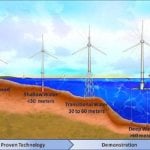The world’s largest ocean energy site, a 40 MW wave farm off the north-west coast of Scotland, has been given the go-ahead by the Scottish government. The planned wave farm will use up to 50 Oyster wave energy machines, which will be put in place along the coast. The energy generated by the installation will be enough to power 30,000 homes, according to the company behind the project, Aquamarine Power.

The Oyster, created by Aquamarine Power, works by converting the energy in nearshore waves into electricity. The company describes the device as “essentially a wave-powered pump which pushes high pressure water to drive an onshore hydro-electric turbine.” The device consists of a hinged flap, the top of which floats on the surface. The flap is anchored to the seabed, at depths of 10 to 15 metres, usually about half a kilometre from shore.
The hinged flap pitches back and forth with the action of the waves in a pumping motion that drives hydraulic pistons. It is these pistons that push the high-pressure water onshore through an underwater pipeline, which then drives the onshore turbine.
According to the manufacturer, the Oyster system’s chief benefits derive from the simplicity of its design. It has few moving parts, no control system or shut-down mode, and no complex electronics as it is entirely mechanical. It can operate even in stormy conditions, simply “ducking” under the largest waves, and it is easy to access. It has minimal environmental impact, the company says, though there has been no large-scale deployment of the devices to date to accurately test this claim.
Aquamarine says that the energy contained within waves, the “last untapped natural renewable resource” on earth, is sufficient to meet global energy demand “five times over.” It puts that potential energy in the waves at 80,000 TWh of electricity per year.
The company says that the Oyster system could be configured for use in desalination plants in places such as the Canary Islands, where rainfall is limited. Instead of using diesel-powered generators to pump seawater through desalination membranes, Oysters could provide a cleaner, more cost-effective solution, without need for fossil fuels.

































